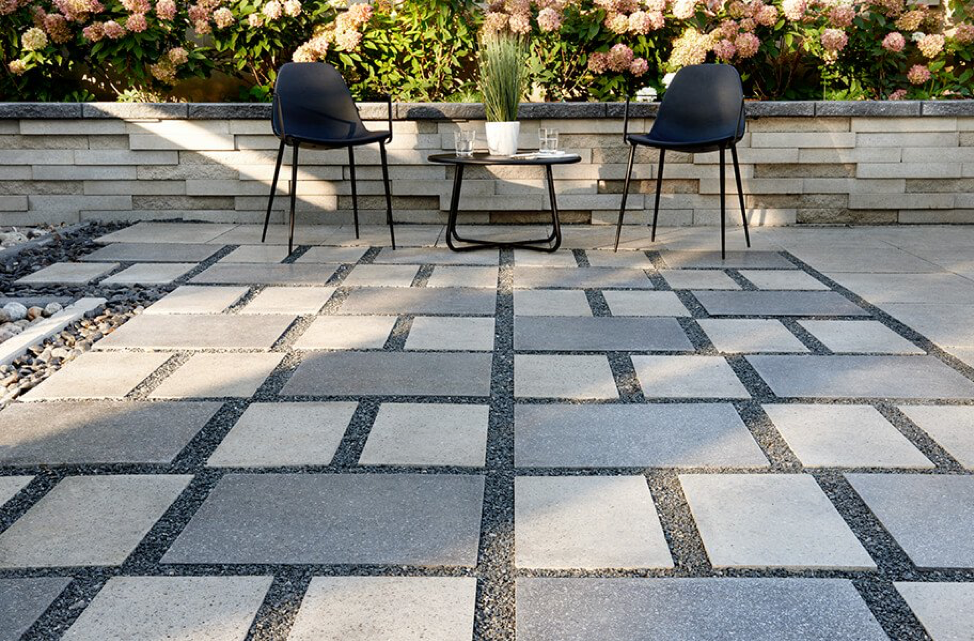What is the Difference Between Pavers and Concrete?
When it comes to building a patio or outdoor space, one major decision that homeowners must make is what type of material to use. The two most common options are pavers and concrete, both of which have their own unique benefits and drawbacks.
Firstly, pavers are individual pieces of material that are laid out on top of a base layer and filled with sand to create a flat surface. Pavers come in a wide variety of materials, including natural stone, brick, and concrete. They are known for their visual appeal and design options, as they can be arranged in various patterns and colors to create a personalized look. Additionally, if there is ever any damage to the surface, only the damaged pavers need to be replaced, rather than having to redo an entire slab.
The downside to pavers is the initial cost, which can be more expensive than concrete. Additionally, regular maintenance is required to keep the surface level and prevent drainage issues, which can add to the long-term cost. However, the return on investment for pavers is often higher due to their curb appeal and durability.
On the other hand, concrete is a solid slab that is poured into place and smoothed out to create a uniform surface. Concrete is a popular choice for larger areas like driveways and pool decks, as it is typically less expensive than pavers. However, if there is damage to the surface, the entire slab may need to be removed and replaced, which can be costly.
One of the major benefits of concrete is its low-maintenance nature. Unlike pavers, concrete does not require regular upkeep to prevent drainage issues or ensure levelness. However, some homeowners may find plain concrete to be less visually appealing than the wide variety of design options available with pavers.
Ultimately, the decision between pavers and concrete will depend on the homeowner’s budget, desired look, and intended use for the outdoor space. Both materials offer their own benefits and drawbacks, and it’s important to carefully consider all factors before making a decision.
Pros & Cons of Pavers and Concrete
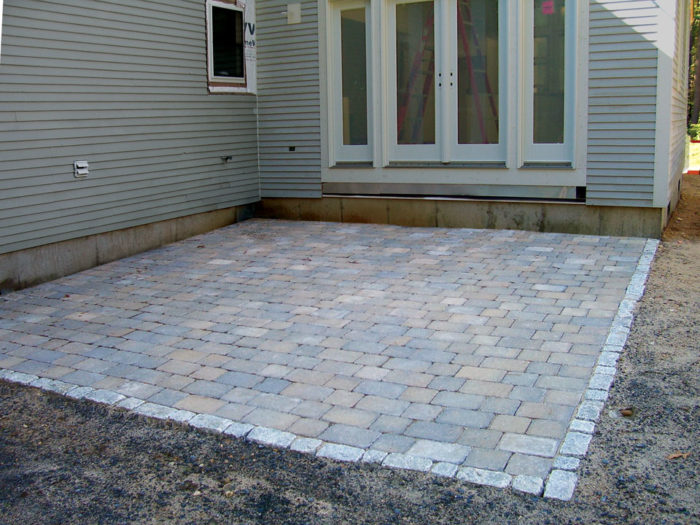
When it comes to creating an outdoor living space, choosing between pavers and concrete surfaces can feel overwhelming. While both materials have their benefits and drawbacks, understanding their respective pros and cons can help homeowners make an informed decision that fits their needs and budget.
Pavers are individual pieces of material that are laid out on top of a base layer and filled with sand. They come in a wide variety of materials, including natural stone, brick, and concrete, and are known for their visual appeal and design options. Pavers can be arranged in a variety of patterns and colors to create a personalized look, and if there is ever any damage to the surface, only the damaged pavers need to be replaced. However, the initial cost of pavers can be more expensive than concrete, and regular maintenance is required to keep the surface level and prevent drainage issues.
Concrete, on the other hand, is a solid slab that is poured into place and smoothed out to create a uniform surface. It is a popular choice for larger areas like driveways and pool decks, as it is typically less expensive than pavers. While concrete may lack the design options of pavers, it makes up for it in its low-maintenance nature. Unlike pavers, concrete does not require regular upkeep to prevent drainage issues or ensure levelness. However, if there is damage to the surface, the entire slab may need to be removed and replaced, which can be costly.
When making a decision between pavers and concrete, it is important to consider the specific needs of your outdoor living space. For homeowners who are looking for a durable, low-maintenance surface, concrete may be the more practical choice. However, if you are looking for a more visually appealing surface that can be customized to your taste, pavers may be the better option despite the higher initial cost and maintenance requirements.
At the end of the day, the choice between pavers and concrete ultimately comes down to personal preference and budget. Whether you opt for pavers or concrete, investing in your outdoor living space can enhance the functionality and enjoyment of your home for years to come.
Cost Comparison of Building a Patio with Pavers vs. Concrete
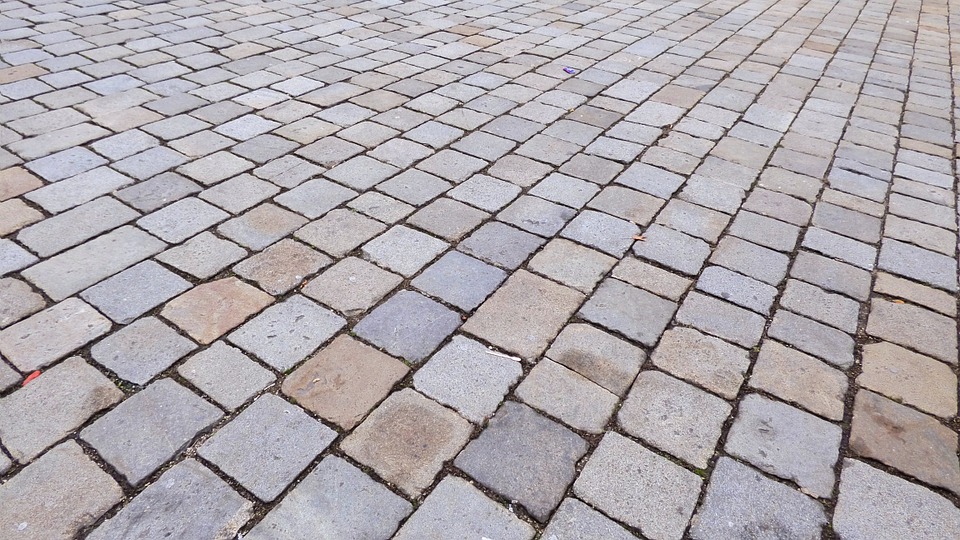
When it comes to building a patio, there are a variety of options to choose from. Two of the most popular materials used for patios are pavers and concrete. While both have their benefits, many homeowners want to know which option is more cost-effective.
The initial cost of pavers is usually higher than concrete. This is because pavers are individual pieces of material that need to be laid out one by one, whereas concrete is poured and smoothed out as a single slab. However, the cost of pavers varies depending on the type of paver used. While natural stone pavers tend to be more expensive, basic pavers made from concrete or brick can be more affordable.
On the other hand, concrete is generally less expensive than pavers. The cost of concrete varies depending on the size of the patio, thickness of the slab, and any design elements that may be added. While concrete is often a more affordable option, it may not offer the same level of customization as pavers.
In terms of repair costs, pavers tend to be less expensive to repair than a concrete patio. If a paver becomes damaged, only that paver needs to be replaced, whereas if there is damage to a concrete patio, the entire slab may need to be replaced. Additionally, pavers are often easier to maintain as they can be easily leveled and any drainage issues can be addressed by adding or removing sand underneath the pavers.
Concrete, on the other hand, requires very little maintenance and is durable against weather conditions. However, it can still develop cracks and shift over time. Repairs to a concrete patio can be more costly than pavers due to the need to remove and replace the entire slab in the case of significant damage.
When it comes to curb appeal, pavers offer a wider variety of visual appeal and design options. Homeowners can choose from a range of patterns, colors, and materials to create a customized look. This wide range of options can come with a higher cost though.
Ultimately, the decision to use pavers or concrete for a patio comes down to the specific needs and preferences of the homeowner. While concrete is generally less expensive and requires less maintenance, pavers offer more design options and can be less expensive to repair. By taking into consideration the cost of pavers versus concrete, as well as repair costs and maintenance requirements, homeowners can make an informed decision when building their patio.
Initial Costs for Installing a Patio with Pavers or Concrete
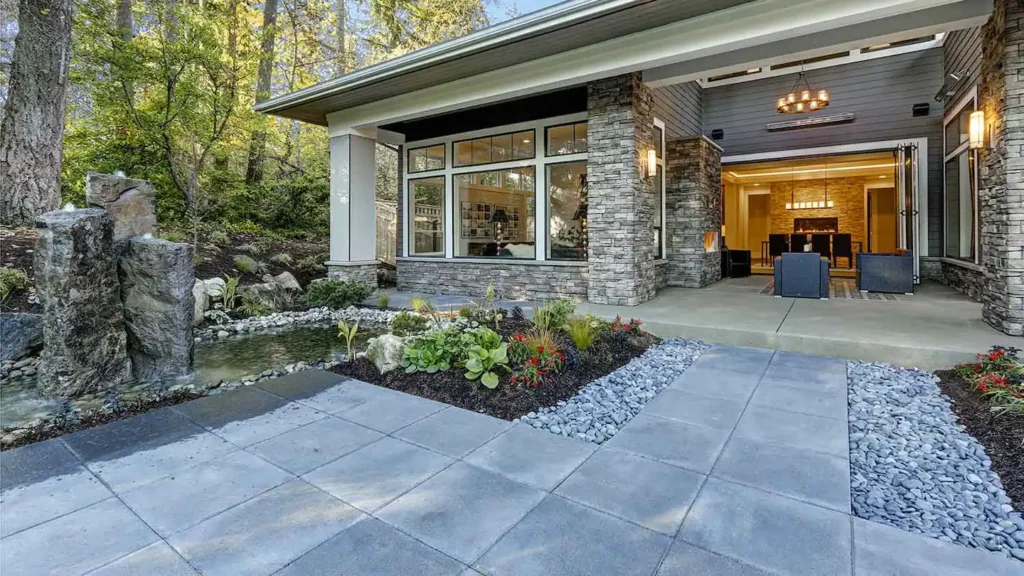
When it comes to installing a patio, one of the most important considerations for homeowners is the initial cost. flooring a patio is an investment that can add value to your home and expand your outdoor living space, but it’s also important to stay within your budget.
The choice between pavers and concrete can impact the initial cost of your patio installation. Let’s take a closer look at each option.
Pavers are individual pieces of material that are laid out one by one to create a surface. The cost of pavers can vary widely depending on the type of material used. Natural stone pavers tend to be the most expensive option, while more basic pavers made from concrete or brick can be affordable.
On average, the cost of pavers per square foot can range from $8 to $20 or more. This includes the cost of the pavers themselves as well as any necessary equipment, supplies, and labor. Depending on the size of your patio and the type of paver you choose, the initial cost of a paver patio can be significantly higher than a concrete patio.
On the other hand, concrete is a more affordable option for patio installation. The cost of a concrete slab patio can vary depending on a number of factors, including the size of the patio, thickness of the slab, and any design elements that may be added.
On average, the cost of a concrete patio can range from $6 to $10 per square foot or more. This includes the cost of the concrete mix, labor, and any additional materials or equipment needed for the installation.
It’s important to note that while concrete is generally more affordable than pavers, it may not offer the same level of customization and design options. Pavers can be installed in a wide variety of patterns, colors, and materials, allowing you to create a unique look for your patio. Concrete, on the other hand, is typically limited to basic design options unless you opt for stamped or stained concrete.
In conclusion, both pavers and concrete have their advantages and disadvantages when it comes to initial costs for patio installation. While pavers offer more design options, they also come with a higher price tag. Concrete, on the other hand, is a more affordable option but may not offer the same level of customization. It’s important to weigh the pros and cons of each option and consider your budget before making a decision.
Long-term Maintenance Costs for a Paver or Concrete Patio
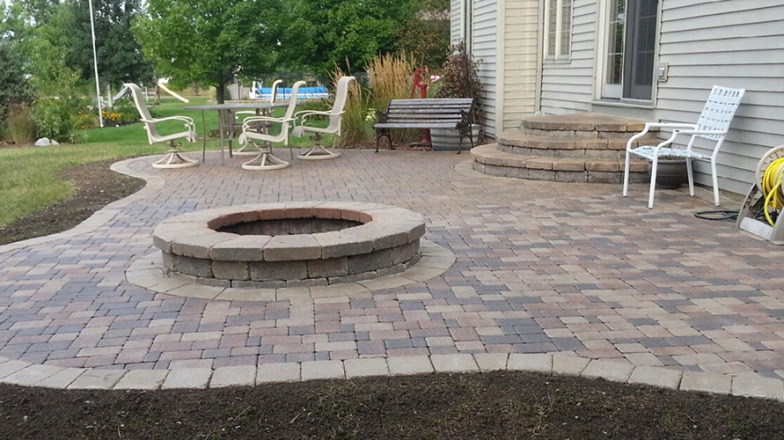
When considering the cost of building a patio, it’s important to think beyond the initial installation expenses. Long-term maintenance costs should also be factored into the decision-making process. Both paver and concrete patios require ongoing care to keep them looking and functioning their best.
Pavers offer a wide range of design options and can be a beautiful addition to any outdoor space. However, they can require more maintenance than a concrete patio. Over time, pavers can shift or become uneven, requiring additional repairs. Weed growth can also be a problem between pavers, which will need to be removed regularly to prevent damage.
In addition to these issues, pavers may need to be replaced over time. Pavers can crack or break from weather conditions, foot traffic, or other external factors. Replacing individual pavers can be time-consuming and expensive, depending on the type of paver and the complexity of the installation.
On the other hand, concrete patios are generally easier to maintain and offer a more durable option. Regular cleaning and sealing can help to prevent stains and keep the surface looking new. While concrete can develop cracks over time, they are typically easier and less expensive to repair than pavers.
In terms of long-term maintenance costs, concrete patios may be a more cost-effective option. However, the choice between pavers and concrete ultimately depends on your personal preferences and budget. If you’re willing to invest more time and money into maintenance and repairs, a paver patio can offer a unique and visually appealing design. If durability and low maintenance costs are your top priorities, a concrete patio may be the better option. Ultimately, a consultation with a professional installer can help you decide which option is best for your outdoor space and long-term budget.
Repair Costs for Pavers or Concrete Patios
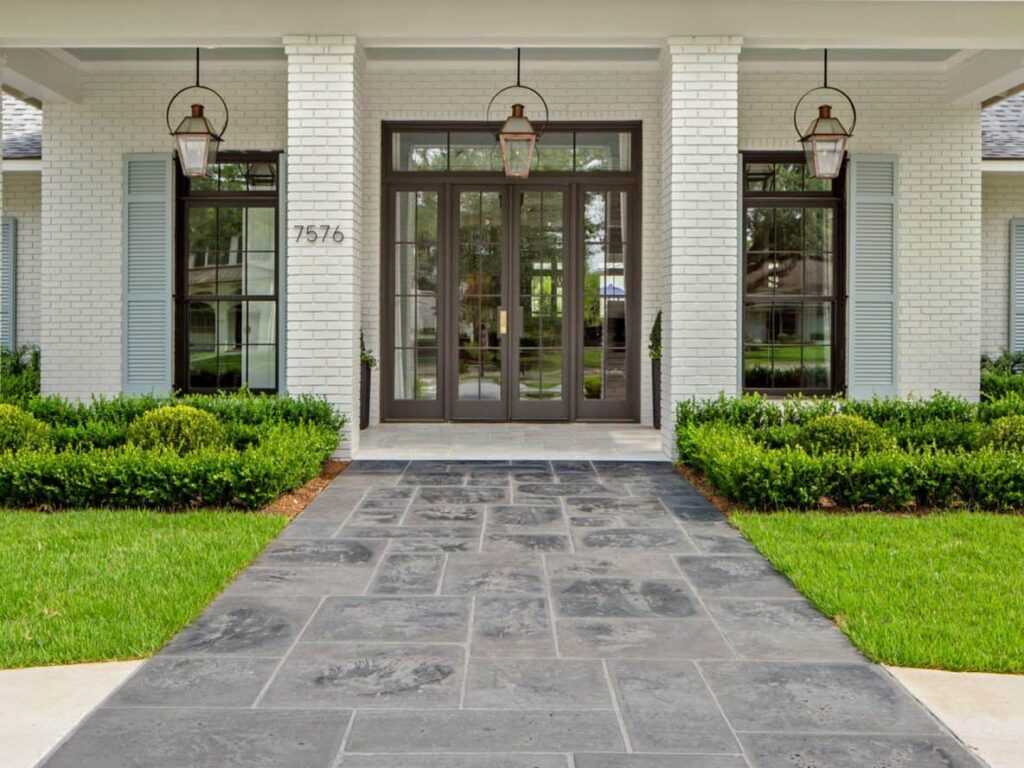
When it comes to outdoor living spaces, both pavers and concrete patios can be excellent choices. However, one important factor to consider is the cost of repairs over time.
Pavers are a great option for those who want a more customizable and visually appealing patio surface. They offer a wide range of design options, and can be made from various materials such as natural stone or concrete pavers. However, over time, pavers can shift and become uneven, which can cause tripping hazards and aesthetic issues. Additionally, weed growth between the pavers can make them look unkempt and will need to be removed regularly to prevent damage.
If your pavers do require repairs, it’s important to note that replacing individual pavers can be time-consuming and expensive. The type of paver used and the complexity of the installation will also impact the cost of repairs. While regular maintenance can help extend the life of your paver patio, the potential for repair costs should be taken into consideration when choosing this option.
Alternatively, concrete patios are typically easier to maintain and offer a more durable option. Regular cleaning and sealing can keep the surface looking new and prevent staining. If cracks do occur, they can typically be repaired more easily and at a lower cost than pavers. However, if the entire slab needs to be replaced due to damage or aesthetics, the cost can be higher than replacing individual pavers.
It’s also important to consider the climate and weather conditions in your area, as they can impact both pavers and concrete. Winter weather can cause pavers to shift or crack, while harsh sun and rain can cause concrete to fade or crack over time.
In the end, the decision to choose pavers or concrete for your patio will ultimately come down to personal preference and budget. While pavers offer a wide range of design options and can be more visually appealing, the potential for higher repair costs should be taken into consideration. On the other hand, concrete patios offer a more durable and low-maintenance option, but may not have the same level of aesthetic appeal.
Design Considerations when Choosing between Pavers and Concrete Slabs
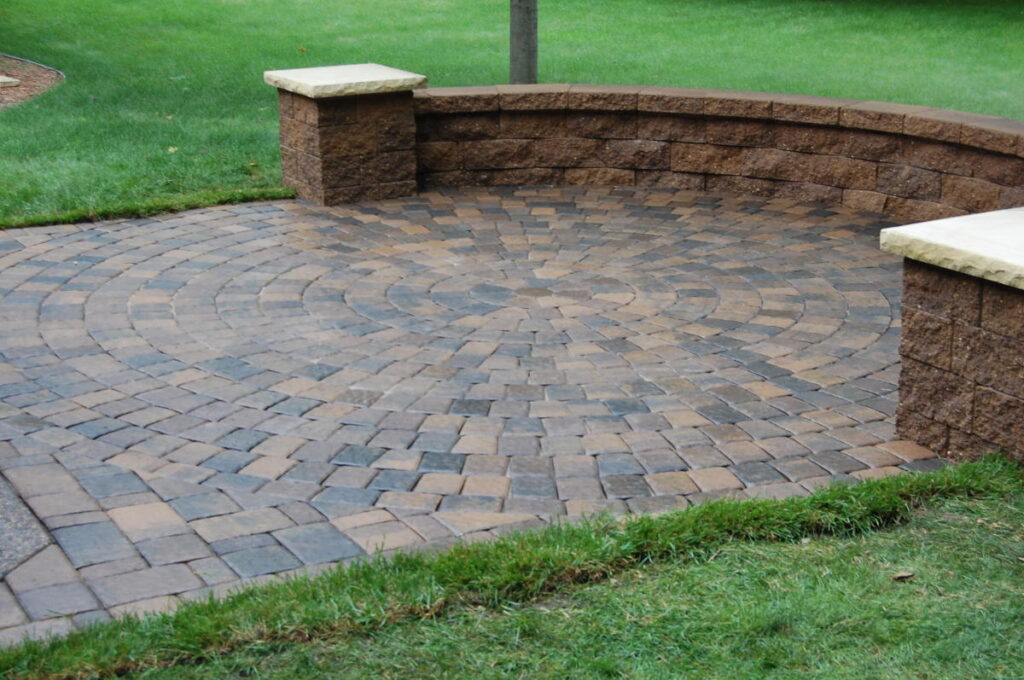
When creating an outdoor living space, it’s important to consider not only the functionality and durability of the materials you choose, but also the design options available. Both pavers and concrete slabs can offer a range of design choices to suit your taste and style.
Individual Pavers:
If you’re looking for a patio surface that can be customized and personalized, pavers are an excellent option. With a multitude of materials, colors, and shapes to choose from, you can create a truly unique and eye-catching design that complements your outdoor décor. Pavers can be laid in any pattern you choose, allowing for a variety of creative designs that can truly transform your patio.
Concrete Slabs:
On the other hand, if you prefer a simpler, more understated look, concrete slabs may be the better choice for your patio surface. Concrete is a versatile building material that can be tinted and stamped with patterns that mimic other materials such as stone or brick. A basic concrete slab can provide a clean backdrop for simple furnishings or additional outdoor décor.
Cost and Maintenance:
While design is important, it’s also crucial to consider the cost and maintenance of the materials you choose. Pavers can be more expensive to install than concrete slabs, and the individual pavers may need to be replaced over time, leading to higher maintenance costs. On the other hand, concrete slabs are more durable and require less maintenance, but if damage does occur, it may be more costly to repair or replace the entire slab.
Curb Appeal:
If you’re concerned with the curb appeal of your outdoor living space, both pavers and concrete slabs can provide an attractive option. Pavers offer a rustic, natural feel that is popular with homeowners, while stamped concrete can create a polished, more refined look.
Final Thoughts:
Choosing between pavers and concrete slabs will depend on several factors, including the desired design, cost, maintenance, and curb appeal. Take the time to consider all of these factors when making your decision, and consult with a professional to ensure that you choose the best material for your outdoor living space. With the right choice, your patio will not only be functional and practical but also an inviting space where you can relax and enjoy the great outdoors for years to come.
Variety of Materials Available for Both Options
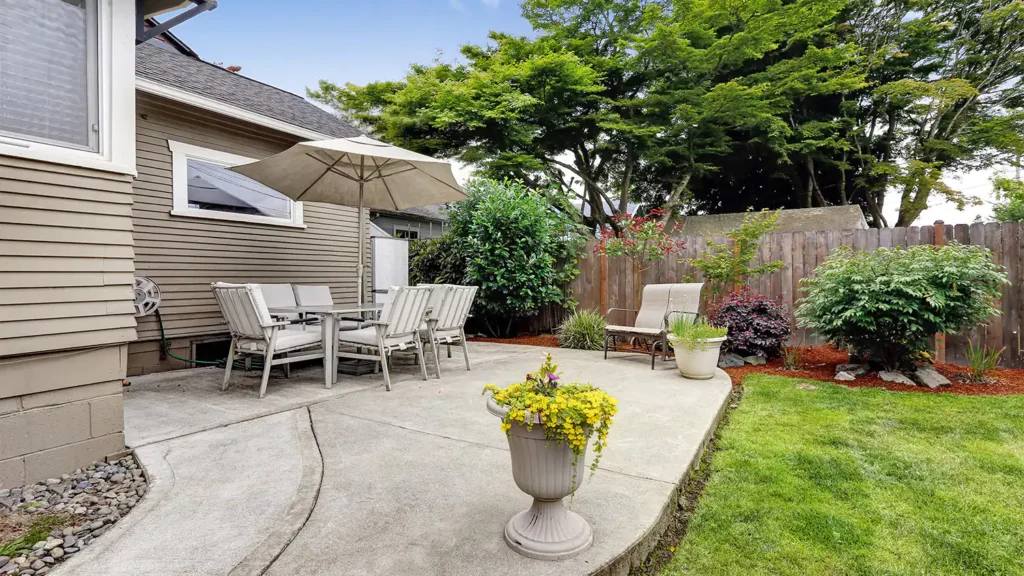
When it comes to choosing between a paver patio and a concrete slab patio, one of the factors that may influence your decision is the variety of materials available for each option.
Pavers come in a wide range of materials, from natural stone like granite and sandstone to brick and concrete pavers. Each material has its own unique texture, color, and shape, allowing you to create a custom look for your patio. Natural stone pavers can add a rustic, earthy feel to your outdoor space, while brick pavers can offer a more classic and traditional look. Concrete pavers come in a variety of colors and patterns, allowing you to create a more modern or contemporary design.
On the other hand, concrete slabs can also offer a variety of design options. Concrete can be tinted or stained to mimic the look of other materials such as natural stone or brick. Additionally, stamped concrete can be imprinted with patterns and designs to create a more visually interesting surface. You can choose from a variety of colors, textures, and finishes to create a unique look for your patio.
It’s important to consider the type of material you want to use for your patio based on its durability and maintenance requirements, as well as its visual appeal. Natural stone pavers may require more maintenance than concrete pavers, as they can be more porous and prone to staining. Concrete slabs may require less maintenance, but they can crack or chip over time, which can be more costly to repair.
Overall, the variety of materials available for both paver patios and concrete slab patios allows you to create a custom look for your outdoor space. Consider the durability, maintenance, and visual appeal of each material option before making a decision to ensure that your patio will last for years to come and complement your outdoor décor.
Design Options with Individual Pavers, Natural Stone, and Stamped Concrete
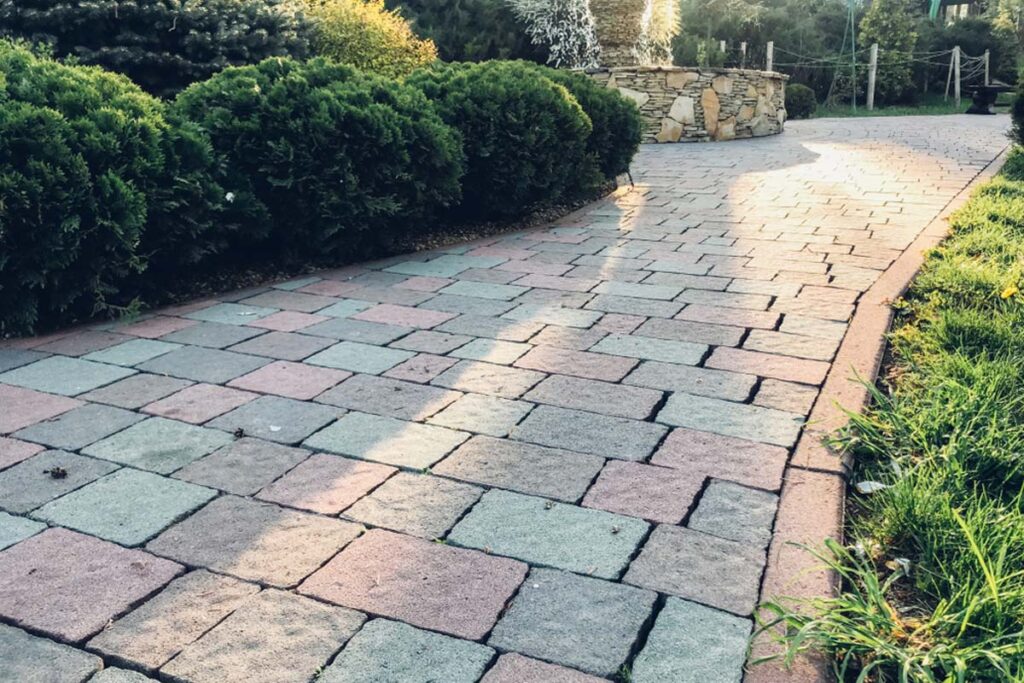
When it comes to designing an outdoor space, choosing the right materials is crucial to creating the look and feel you want. Pavers, natural stone, and stamped concrete are all popular choices for patios, walkways, and other outdoor living areas, each offering its own unique design options.
Individual pavers allow for a high level of customization. With a wide variety of sizes, shapes, and colors available, you can mix and match to create a unique pattern that reflects your personal style. Whether you prefer a more traditional look or something more modern and eclectic, pavers offer endless design possibilities.
Natural stone is another option for creating a custom look. Granite, sandstone, travertine, and other stones all offer unique textures and patterns that can add a touch of rustic elegance to your outdoor space. Natural stone can also be cut into irregular shapes to create a more organic feel, perfect for creating a path that winds through a garden or backyard.
Stamped concrete is a great option for those seeking a more polished, uniform look. With a wide range of patterns available, including brick, stone, and tile, you can mimic the look of other materials without the added expense. Stamped concrete is also a great choice for those seeking a low-maintenance option, as it requires minimal upkeep and is durable enough to withstand harsh weather conditions.
One of the key benefits of using pavers, natural stone, or stamped concrete is the ability to customize the design to suit your unique style and needs. Whether you want a simple, understated look or something more elaborate and eye-catching, these materials offer a great degree of flexibility and creative possibilities. So, when it comes to designing your outdoor space, consider the many design options available with pavers, natural stone, and stamped concrete, and create a one-of-a-kind look that you’ll love for years to come.
Weather Conditions to Consider when Installing a Paver or Concrete Patio
When it comes to installing a patio, choosing the right material is just one part of the process. Another important factor to consider is your local weather conditions. Both pavers and concrete have their pros and cons when it comes to durability and maintenance in different climates.
For example, if you live in an area with harsh winters or frequent freeze-thaw cycles, pavers may be the better option. Pavers are able to flex and shift with the ground, while concrete slabs can crack under the pressure of expanding and contracting soil. Additionally, pavers are typically installed with sand between them, which allows for water to drain through and prevents the formation of ice.
On the other hand, if you live in an area with hot summers and little rainfall, concrete may be the way to go. Concrete can withstand high temperatures without becoming too hot to walk on, and it won’t shift or move during long periods of drought. Plus, a concrete patio can be sealed to prevent staining and damage from UV rays.
Regardless of where you live, it’s important to choose a paving material that will stand up to your local weather conditions. If you’re not sure which material is right for you, consider speaking with a professional paver or concrete installer who can give you personalized recommendations based on your specific climate and needs.
In addition to material selection, it’s also important to consider proper installation techniques to ensure your patio can withstand the elements. This includes proper drainage to prevent water from pooling and causing damage, as well as using high-quality materials and tools to ensure the job is done right the first time.
Overall, taking weather conditions into account is an important step in building a long-lasting and beautiful patio. By choosing the right material and installation techniques, you can create an outdoor space that you can enjoy for years to come, no matter what the weather throws your way.
Other Uses of Pavers and Concrete Surfaces
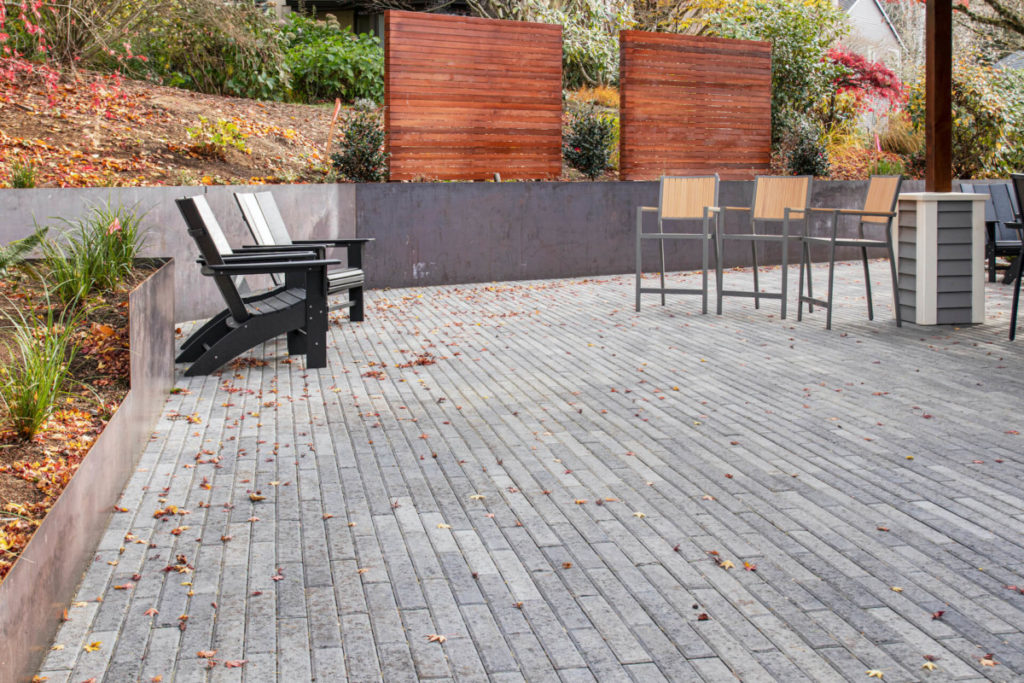
When most people think of pavers and concrete surfaces, they likely picture them as a means to create a sturdy and aesthetically pleasing patio or driveway. While these are certainly common applications of these materials, they are far from the only ways in which pavers and concrete can be used to enhance outdoor spaces.
One popular alternative use for pavers is using them to create a pool deck. Pavers are an ideal material for this application because they resist damage from chlorine and other pool chemicals, and their textured surface can provide additional grip for wet feet. Plus, by choosing the right colors and patterns, you can create a stylish and cohesive look that ties your pool area together.
Another creative use for pavers is to create a garden path. You can use pavers to highlight particular areas of your garden, or to create a winding path that encourages visitors to explore your space. By using pavers in this way, you can create a natural and organic feel that blends into your existing landscaping.
Of course, concrete surfaces have their own range of alternative uses as well. For example, you may choose to use concrete to create a retaining wall in your garden. By using stamped or engraved concrete to create the wall’s surface, you can add texture and visual interest to an otherwise utilitarian space.
Concrete can also be used to create outdoor furniture. By casting concrete into different shapes and sizes, you can create unique and personalized seating options that can withstand even harsh weather conditions. Plus, by painting or staining the concrete, you can add color and style to your furniture pieces.
Ultimately, there are countless ways to incorporate pavers and concrete surfaces into your outdoor living space. Whether you choose to use them to create a patio, a pool deck, or something else entirely, these materials offer durability and visual appeal that can’t be achieved with other building materials. By getting creative and exploring different applications of pavers and concrete, you may just find a new way to add charm and functionality to your outdoor oasis.
Pool Decks, Driveways, Walkways, Curb Appeal & More
Pool Decks, Driveways, Walkways, Curb Appeal & More: Pavers vs. Concrete
When it comes to creating outdoor spaces, choosing the right materials is an important decision. Pool decks, driveways, and walkways are all key elements of your home’s exterior, and they each require durable materials that can withstand harsh weather conditions and regular use.
Two of the most popular materials used for these outdoor spaces are pavers and concrete. Each has its own unique advantages and disadvantages, and understanding the differences between them can help you make an informed decision that fits your personal style and budget.
Pool Decks:
Pavers are an ideal choice for pool decks because of their slip-resistant surface and ability to withstand chemicals. They come in a wide range of colors and patterns, making it easy to create a personalized look that complements your home’s exterior and enhances your backyard experience. While pavers may have a higher initial cost than concrete, their durability and easy maintenance make them a cost-effective investment in the long run.
Driveways:
When it comes to driveways, concrete may be the better choice. It is less likely to shift or settle over time, making it a low-maintenance option that can withstand heavy vehicle traffic. Concrete is also easier to install as a single slab, making it a more affordable option than laying individual pavers. However, stained and stamped concrete can add visual interest and curb appeal, allowing you to create a unique look that stands out from traditional concrete surfaces.
Walkways:
Pavers are an excellent choice for creating walkways because of their slip-resistant surface and the wide variety of textures, colors, and shapes available. Pavers can be cut to fit any space, making it easy to create a winding path through your garden that enhances the natural beauty of your landscaping. Concrete walkways can also look great and be durable, but they require regular maintenance to prevent cracking or settling.
Curb Appeal:
Both pavers and concrete can be used to enhance the curb appeal of your home. Pavers offer a range of patterns and designs that add visual interest and texture to your landscaping. They can be used to create stunning entryways, patios, and outdoor living areas. Concrete can also be used for these purposes, but stamped or stained concrete can add a personalized touch that enhances the aesthetic appeal of your home.
In conclusion, when it comes to choosing between pavers and concrete for your outdoor living spaces, the decision comes down to your personal style, budget, and needs. Pavers offer a wide range of colors and patterns that can create a personalized outdoor space, while concrete offers durability and affordability. Ultimately, choosing the right materials for your pool deck, driveway, walkway, and curb appeal can enhance your home’s exterior and create a welcoming environment for you and your guests to enjoy.
Conclusion – Is it Cheaper to Build a Patio with Pavers or Concrete?
In conclusion, the decision to choose between pavers and concrete for your patio largely depends on your personal preferences, budget, and the specific needs of your outdoor space. While both materials have their own unique advantages, there are certain factors that may make one more suitable than the other.
Pavers are a great option for creating a personalized look and feel that complements your home’s exterior. They are durable, slip-resistant, and come in a wide range of colors and patterns, making it easy to create a cohesive design that enhances your outdoor living space. However, pavers may have a higher initial cost and require regular maintenance to prevent shifting or settling.
On the other hand, concrete is a cost-effective option that is low-maintenance and can withstand heavy vehicle traffic. It can be used to create a basic slab or be stained or stamped to add visual interest and enhance curb appeal. However, concrete may not offer the same level of flexibility and design options as pavers.
Ultimately, the decision to choose between pavers and concrete will depend on your specific needs and budget. It is important to consider factors such as material cost, installation and maintenance costs, durability, and visual appeal before making a decision. With proper planning and professional installation, either option can create a beautiful and functional outdoor living space that adds value to your home and enhances your enjoyment of your property.

